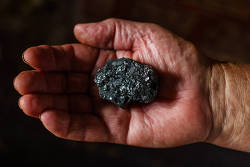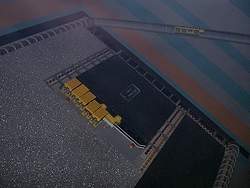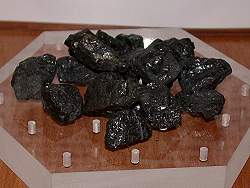Coal Mines
Collieries


 Saarländisches Bergbaumuseum Bexbach.
Saarländisches Bergbaumuseum Bexbach.

In coal mines a strange black rock is mined, with some remarkable characteristics. It is rather soft, rather light, and it burns, at least if it is dried before. This rock is composed mainly of carbon, which burns with the oxygen in the air to carbon dioxide and produces a lot of energy. Its value is known for millennia, but first it was only used to heat houses, later it was used by blacksmiths.
It took some time until man learned how to produce coalite in a process called Coalite Process or Parker Process. The coal is heated to 600 °C, which causes water, sulfur and gases to leave and only the pure carbon remains. Coalite burns hotter, has less ash, and is used for furnaces, steam engines and smiths fires. It is the base of the industrial revolution and the energy source of generations. The gases which are produced during the process are partly burning, so when they cool down and the steam is condensed, the rest is often used for cooking and heating.
During centuries coal mines were the extremely important for all industrial countries. In the 19th century, coal mines and iron mines were the basis of the industrial revolution. In the 20th century other energy sources, especially the oil, started to become more important than coal.
To understand the mining of coal it is necessary to understand its typical deposits. The most important coal formations were deposited during the Carboniferous (359 to 299 Ma). The Carbon was named such because of the typical coal deposits. At this time, Earth was much warmer with a higher amount of carbon dioxide in the atmosphere and thus a much higher glasshouse effect. Also, central Europe was located near the equator at this time. This resulted in abundant vegetation, with subtropic or tropic rain forests all over the continent. But similar stories happened in this Era all over the world, and so the first geologists in the 18th and 19th century called the layers with the many coal Carbon, the age of the coal.
Numerous shallow basins with a continuous subsidence were filled with a sort of swamp. The trees and leaves formed a moor on the wet ground, the dead trees did not rot in this swamp, but formed a layer of carbon rich peat. After the deposit of several dozen meters of peat, the whole area was covered by sand and gravel from the hills around, during exceptional events like very heavy storms with flash floods. Layer above layer of plant remains and sand were deposited and subsided, frequently covered by mud.
After some time the depth and thus temperature and pressure increased, and the sand was transformed into sandstone, the clay became siltstone. The peat was compressed too, the water pressed out. Many components of the plant remains were also pressed out, until just carbon with some water, sulfur and clay minerals remained. This transformed peat into lignite and then coal, this process is called coalification.
- peat contains less than 50% carbon and is not always considered as coal.
- lignite or brown coal contains 50 to 65% carbon, it is used for heating, pressed in egg or brick shape.
- coal or black coal contains 65 to 90% carbon. It is converted into coalite and used in furnaces.
- anthracite more than 90% carbon is the best possible quality. It is used for various purposes, in the chemical industry, e.g. to lubricate locks and much more.
The result is typically coal formations of several hundred meters. The coal leads are often very thin, but starting with 50 or 60 cm they are thick enough to be mined. The tectonic forces which caused the subsidence typically slanted the layers and so it is very common that coal seams are inclined with about 30°. The mining is thus different for the access tunnels and adit, and for the mining of the coal. Access tunnels ar normal tunnels where a man can stand upright, were mine trains and conveyor belts are loacted. The mining in the coal lead follows the lead, which is scratched out by a special machine. The surrounding rock is not altered.
The mining would leave a very huge and very flat space, which would collapse almost immediately. There are two ways to cope with this, either allow a controlled collapse or fill it with other material. The amount of removed material is extremely high in a coal mine. So it is not always possible to fill all spaces. But controlled collapse has certain disadvantages, as the collapse works its way up to the surface and after some time destroys the villages above. Even if the gap was filled and the filled in material shrinks a bit when it is compressed, collapses are possible.
Coal mining is still important today. But the character of the interesting coal deposits is different. These classical coal deposits are too expensive to mine. Some countries forced the mining for some decades by subsidizing local coal, primarily for political reasons, like being more independent of foreign energy. But still, this kind of mining is not relevant any more. Modern coal fields are typically huge and effortless to mine, e.g. in huge opencast mines. The quality of the coal is not as important as it was. Probably the most important of those modern mines are located in Australia, producing coal for the iron industry in Japan and worldwide. Coal is mined open cast and transported with extremely long trains through the desert to the sea, where it is shipped.
Literature
- Larry Thomas (2002):
Coal Geology,
Hardcover: 396 pages, John Wiley & Sons (October 18, 2002), ISBN: 0471485314.
 amazon.com
amazon.com
 Search DuckDuckGo for "coal mining"
Search DuckDuckGo for "coal mining"
 Index
Index Topics
Topics Hierarchical
Hierarchical Countries
Countries Maps
Maps